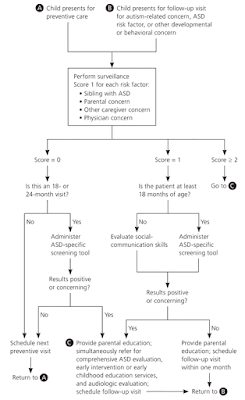by Claire Lockwood
Because autism is a spectrum disorder and behavioral manifestations are uniquely individual, there is no single “best treatment” plan. Interventions that are helpful to one child may be non-therapeutic for another. Treatment should be discussed with a primary care provider before implementation, and should be tailored to each child's individual needs.
Currently there are several types of treatment. Outlined below are four main categories of treatment, which include: 1) Behavior and Communication Approaches, 2) Dietary Approaches, 3) Medication, and 4) Complementary and Alternative Medicine.
- Behavior and Communication Approaches. There are many types of behavior and communication approaches, including occupational therapy, speech therapy, sensory integration theory, and applied behavioral analysis. Specific kinds of applied behavioral analysis include: Discrete Trial Training (DTT), Early Intensive Behavioral Intervention (EIBI), Pivotal Response Training (PRT), and Verbal Behavior Intervention (VBI). To learn more about each of these behavior and communication approaches please visit the Centers for Disease Control website at: http://www.cdc.gov/ncbddd/autism/treatment.html#types
- Dietary Approaches. Most dietary approaches have been developed by therapists, but have not been substantiated to the point of widespread recommendation. Dietary approaches, like all other therapeutic interventions, must be tailored to the individual. Dietary adjustment may include removing a particular type of food or enhancing a diet with vitamin and mineral supplements. The idea behind dietary modification is that certain foods trigger symptoms of ASDs. Some mothers of autistic children allege that diet plays a part in the way their child behaves and feels. Always consult with a doctor or dietician before implementing dietary changes.
- Medication. There is no medicine that cures autism and no medicine that targets the predominant symptoms. However, there are medications that relieve specific behavioral manifestations not uncommon to individuals with ASD. Medications may address anger/aggression, hyperactivity, depression, seizure disorders, or the inability to focus. To learn more about pharmacological interventions, please visit http://www.nimh.nih.gov/health/publications/autism/complete-index.shtml#pub4
- Complementary and Alternative Medicine. “CAM” therapy is often controversial since it is not usually advertised by physicians. According to the CDC website, “as many as one third of parents of children with an ASD may have tried complementary or alternative medicine treatments, and up to 10% may be using a potentially dangerous treatment” (ASDs, 2010). Visit the National Institute of Health website for more information on CAM: http://nccam.nih.gov/health/whatiscam/#1
It is difficult to weigh the risks and benefits of various forms of therapy since each patient requires an individually tailored treatment plan. However, according to the National Institute of Mental Health, most professionals agree that early intervention is important and that “most individuals with ASD respond well to highly structured, specialized programs.” In my personal research of ASD treatment options, I have yet to come across documented “risks” associated with non-pharmacological treatment measures. However, physicians should be consulted for the risks and benefits that accompany drug therapy.
Reference:
Autism Spectrum Disorders (ASDs). (2010). Retrieved from http://www.cdc.gov/ncbddd/autism/treatment.html#types

